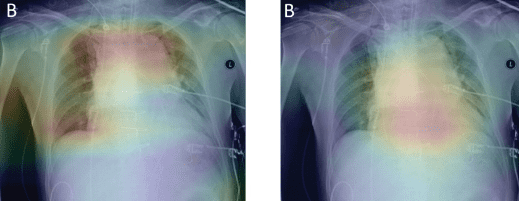|
Acute Chest Pain CXR AI | Zero-Gravity X-Ray
January 23, 2023
|
|
|

|
|
Together with
|

|
|
|
“Despite these guidelines, the firearm was not mentioned.”
|
|
A statement from a Brazilian imaging center company after a man was shot with his own gun by one of their MRI scanners after completing all MRI safety processes.
|
|
|
If you’re enjoying The Imaging Wire, please invite a few radiology friends to sign up so they can enjoy it too. Plus, you can use the referral link at the bottom of this newsletter and earn Imaging Wire swag for each new reader you refer.
|
|

|
|
Patients who arrive at the ED with acute chest pain (ACP) syndrome end up receiving a series of often-negative tests, but a new MGB-led study suggests that CXR AI might make ACP triage more accurate and efficient.
The researchers trained three ACP triage models using data from 23k MGH patients to predict acute coronary syndrome, pulmonary embolism, aortic dissection, and all-cause mortality within 30 days.
- Model 1: Patient age and sex
- Model 2: Patient age, sex, and troponin or D-dimer positivity
- Model 3: CXR AI predictions plus Model 2
In internal testing with 5.7k MGH patients, Model 3 predicted which patients would experience any of the ACP outcomes far more accurately than Models 2 and 1 (AUCs: 0.85 vs. 0.76 vs. 0.62), while maintaining performance across patient demographic groups.
- At a 99% sensitivity threshold, Model 3 would have allowed 14% of the patients to skip additional cardiovascular or pulmonary testing (vs. Model 2’s 2%).
In external validation with 22.8k Brigham and Women’s patients, poor AI generalizability caused Model 3’s performance to drop dramatically, while Models 2 and 1 maintained their performance (AUCs: 0.77 vs. 0.76 vs. 0.64). However, fine-tuning with BWH’s own images significantly improved the performance of the CXR AI model (from 0.67 to 0.74 AUCs) and Model 3 (from 0.77 to 0.81 AUCs).
- At a 99% sensitivity threshold, the fine-tuned Model 3 would have allowed 8% of BWH patients to skip additional cardiovascular or pulmonary testing (vs. Model 2’s 2%).
The Takeaway
Acute chest pain is among the most common reasons for ED visits, but it’s also a major driver of wasted ED time and resources. Considering that most ACP patients undergo CXR exams early in the triage process, this proof-of-concept study suggests that adding CXR AI could improve ACP diagnosis and significantly reduce downstream testing.
|




|
|
- Zero-Gravity X-Ray: MinXray’s portable X-ray system was used to acquire the first zero-gravity diagnostic radiographs. Members of the Diagnostic Ultra-portable X-ray for Space (DUXS) program and MinXray team members boarded a multi-parabolic flight and performed a series of zero-gravity scans, including recreating Röntgen’s famous X-ray of his wife’s hand. MinXray has done a solid job demonstrating its performance in extreme environments, previously using its scanner on a Mt. Everest expedition.
- Knee MRI AI Reconstruction Evidence: NYU and Meta researchers showed that deep learning reconstruction can significantly reduce MRI scan times without sacrificing image quality. After training with 298 3T MRI knee exams, the researchers scanned 170 patients using the DL reconstruction protocol and a conventional accelerated protocol, finding that DLR nearly halved their scan times (10 min to 5.5 min) and achieved higher image quality scores from four MSK rads (P < .001). This is the latest in a series of AI collaborations from NYU and Meta/Facebook.
- Oxipit’s Autonomous AI Funding: Oxipit completed a $4.9M funding round (total raised now $6.6M) to further develop its autonomous imaging AI apps, expand into new markets (specifically the UK and Taiwan), and file for FDA clearance. This fresh funding follows a big 2022 for Oxipit, when its ChestLink solution became the first regulatory-approved autonomous imaging AI product (it doesn’t involve rads w/ negatives).
- Shot By MRI: A Brazilian lawyer and pro-gun influencer was shot in the abdomen by his own gun while accompanying his mother for an MRI exam. The 40-year-old man reportedly didn’t follow instructions to remove metal objects or inform the MRI team about his firearm. Upon entering the MRI room, the magnet pulled the gun from his waist and pulled the trigger. He’s still hospitalized in São Paulo.
- Simulation-Based TTE Training: Teaching transesophageal echocardiography (TEE) with the help of simulation improved cardiology fellows’ knowledge, skills, and self-assessed proficiency. A French multicenter randomized trial (n=324) found that fellows who trained using TEE simulation displayed higher theoretical test knowledge scores (47.2% vs. 38.3%), higher practical test scores (74.5% vs. 59%), performed TEEs more quickly (8.3 mins vs. 9.4 mins), and achieved better self-assessments than those in the traditional training group.
- DM AI + ABUS AI: A new Insights into Imaging study highlighted the diagnostic potential of combining separate mammography AI and breast ultrasound AI tools. The researchers used ScreenPoint’s mammo AI solution and Qview’s ABUS AI solution to analyze exams from 430 Chinese women with predominantly dense breasts. The multimodal AI approach was more accurate than either AI model on its own (AUCs: 0.865 vs. 0.832 vs. 0.841), and matched the sensitivity of four radiologists when operating at the same specificity.
- Peak ED Imaging Disparities: Emory University researchers found that emergency imaging disparities can be exacerbated when EDs are busiest. Analysis of 321k ED visits (102k during peak hours) revealed that Black patients experienced longer image acquisition and assessment times than White patients during both peak and non-peak hours (TR: 1.030 & 1.112), specifically increasing Black patients’ ED length of stay during peak hours. The study also identified imaging acquisition and assessment time disparities among women (TR: 1.146 & 1.139) and patients with primary health plans (TR > 1.00).
- Clarius Power Fan: Clarius Mobile Health introduced its new Power Fan HD3 accessory, a unique ultrasound attachment that provides Clarius’ HD3 handheld POCUS scanners with continuous power and cooling, allowing clinicians to use the scanners all-day without interruption.
- No AI Education: The calls for AI education appear to be growing louder, after a STAT article suggested that med schools are “missing the mark” on AI and a Clinical Radiology study detailed the UK’s insufficient imaging AI training. The STAT article argued that med schools’ lacking AI curriculums are creating AI “knowledge gaps” and might hinder future physicians’ ability to spot AI mistakes. The Clinical Radiology survey of 149 trainees (from every UK radiologist training program) revealed that 98.7% believe AI should be taught, but only one program includes AI training.
- National Health Spending Growth: CMS reported that national health spending grew by nearly 3% to $4.3T in 2021. Although a massive number, 2021’s spending growth represented a major slowdown from the 10% growth seen in 2020, due primarily to reduced COVID-related government spending. Federal health expenditures vaulted up 37% in 2020 as the pandemic swept across the nation, then fell by 3.5% in 2021.
- Shields Health Care Class Actions: Shields Health Care is facing federal and state class action lawsuits over its 2022 data breach that exposed nearly 2M patients’ information. The lawsuits allege that the major Massachusetts imaging center company failed to protect patient information, waited too long to notify patients of the breach, didn’t provide adequate details in its notifications, and offered insufficient remedial services. If that looks familiar, it might be because the class action against US Radiology Specialists featured nearly identical allegations.
|
|
Blackford’s AI Value Matrix
Working out your AI business case? Check out this helpful Blackford Analysis post detailing how to create your AI Value Matrix based on your organizational objectives and value indicators.
|
|
Intelerad’s RSNA Insights
Check out this first-of-its-kind Imaging Wire Show held on-site at RSNA 2022, with Intelerad leaders Morris Panner and A.J. Watson. We discuss Intelerad’s latest initiatives and acquisitions, its expanding cloud focus, and its strategy heading into 2023, making this a must-watch episode if you’re involved with Intelerad or working on your own enterprise imaging strategy.
|
|
- Healthcare’s data fluency challenges have existed for years, and they are increasingly getting in the way of care delivery and the completion of AI projects. This Enlitic report details the three data fluency challenges that healthcare must overcome, and how it addresses these challenges.
- Annalise.ai doubled-down on its comprehensive AI strategy with the launch of its Annalise Enterprise CTB solution, which identifies a whopping 130 different non-contrast brain CT findings. Annalise Enterprise CTB analyzes brain CTs as they are acquired, prioritizes urgent cases, and provides radiologists with details on each finding (types, locations, likelihood).
- Watch industry leaders and trendsetters in radiology, Dr. Krishna Nallamshetty, CMO at Radiology Partners, and Dr. Ron Shnier, CMO at I-MED Radiology Network, share their perspectives on the CARPL platform, from clinical trials to clinical deployment at RSNA 2022.
- “This clinical experience, in a real critical time, proved that this ultra-low-field strength MRI, portable and self-shielding, could image patients in the most difficult circumstances.” That’s one of the clinical perspectives shared by Hyperfine Swoop users in this ASNR 2022 panel.
- It says a lot when a solution works so well for a radiology department that they decide to perform a study to quantify its benefits. In this Imaging Wire Q&A, University Hospital of Zurich’s Thomas Frauenfelder discusses his experience and study on Riverain Technologies ClearRead CT.
- When one of Precision Imaging Centers’ 3T MRIs wasn’t meeting their requirements, they implemented Subtle Medical’s SubtleMR solution, rather than purchasing a new scanner or an expensive upgrade. See how SubtleMR enhanced Precision’s patient throughput and comfort, without compromising image quality in this case study.
- Did you know one quarter of healthcare organizations have experienced a cyber-attack in the last year? This Change Healthcare animation explains how 3rd-party certified cloud-native enterprise imaging can help secure IT infrastructure that might be exposed with re-platformed imaging systems.
- Working on improving your radiology department’s performance? This Novarad post details the many aspects that contribute to a radiology department’s performance, and how Novarad can help.
- Siemens Healthineers’ AI-Rad Companion family of AI-powered workflows has been expanding across modalities and anatomies, automating repetitive tasks and helping improve diagnostic precision. See how AI-Rad Companion can fully integrate into your workflows and support your clinical outcomes here.
- Check out this Imaging Wire Show with United Imaging’s Jeffrey Bundy and Mike Coulter, who detail their unique approach to medical imaging innovations. If you’re trying to figure out a simpler and more scalable way to run your imaging organization, this interview is a great way to start.
- We talk a lot about radiology practices’ AI adoption, but usually don’t have much evidence to back it up. That changes with this new Arterys report detailing how and why 30 US radiology groups became imaging AI adopters.
|
|
|
Share The Imaging Wire
|
|
Spread the news & help us grow ⚡
|
|
Refer colleagues with your unique link and earn rewards.
|

|
|
|
|
Or copy and share your custom referral link: *|SHAREURL|*
|
|
You currently have *|REFERRALS|* referrals.
|
|
|
|
|